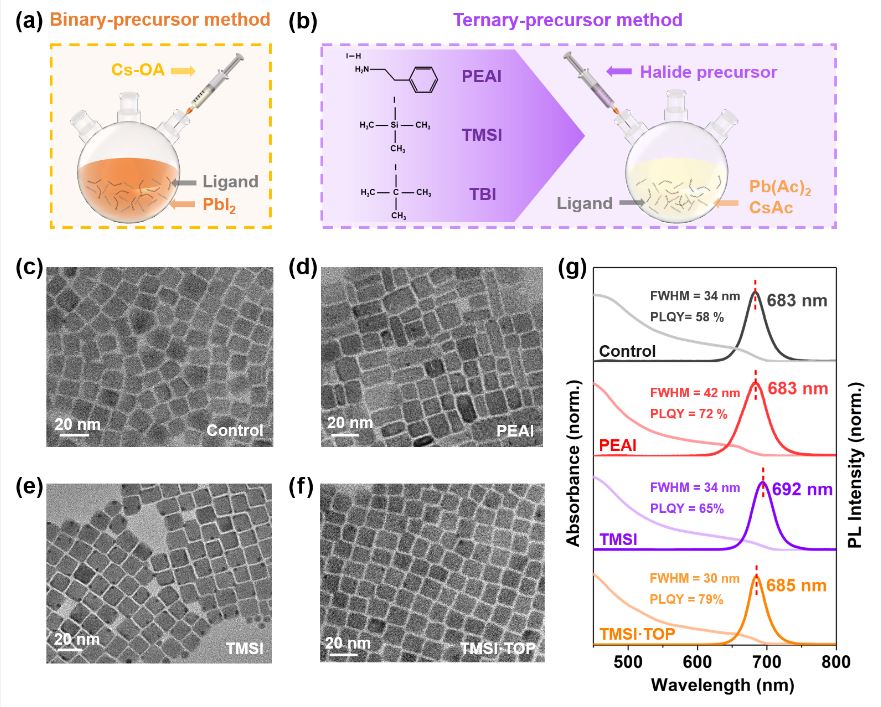Researchers from Beihang University in China have designed a solar cell based on perovskite quantum dots (PDQs) that reportedly has a power conversion efficiency exceeding 16%.
“Currently, the biggest challenges with this kind of cell are device photovoltaic performance and operational stability are poor,” researcher Xiaoliang Zhang told pv magazine. “If we will make the quantum dot solar cell stable enough and meet commercial standards, we strongly believe this type of solar cell is very promising and competitive with other solar cells.”
For the fabrication of the cell, the research group combined a precursor engineering of PQDs with a surface of covalent type iodide compound trimethylsilyl iodide (TMSI) and a chemical stripping treatment (CST) technique. This purportedly improves the orientation of PQD solids, while decreasing their intrinsic surface defects.
According to the academics, the presence of iodide is able to reduce to a large extent the surface trap states of PQDs and thus suppress trap-assisted nonradiative recombination. They also added nucleophilic trioctylphosphine (TOP) into the crude TMSI-based PQD solution.
“We conceived that the interaction between the TOP and PQD can be considered as a chemical stripping process,” the scientists said. “The results reveal that TMSI·TOP-based PQDs show decreased size with a narrower size distribution compared with that of TMSI-based PQDs.”
The researchers tested the solar cell under standard illumination condition and found the device achieved an efficiency of 16.25%, an open-circuit voltage of 1.23 V, a short-circuit current density of 17.73 mA cm−2, and a fill factor of 0.745.
“Due to the high quality and iodine-rich surface of TMSI·TOP-based PQDs, the cells also exhibited good stability,” they said. “The improved photovoltaic performance of PQDSCs could be ascribed to the facilitated charge carrier transport within the PQD solids and substantially diminished trap-assisted charge carrier recombination, originating from the high orientation of PQD solids and improved surface chemistry of PQDs, respectively.”
They described the cell technology in “Highly Orientated Perovskite Quantum Dot Solids for Efficient Solar Cells,” which was recently published in Advanced Materials.
“We did not estimate the cost at this stage,” Zhang stated. “However, the fabrication of this type of solar cell is relatively easy compared with other solar cells, and also compatible with the scaleable fabrication approaches, such as using roll-to-roll spraying or printing techniques.”
Quantum dots based on perovskites have been particularly attractive to researchers working in photovoltaics, as they have already demonstrated efficiencies beyond 16%. Their potential advantages include high performance, fewer defects, better stability, simple fabrication methods, easy tunability to absorb different parts of the light spectrum, and production using more environmentally solvents. However, it will take a lot of work to fully understand PQDs and realize some of these advantages.
This content is protected by copyright and may not be reused. If you want to cooperate with us and would like to reuse some of our content, please contact: editors@pv-magazine.com.




1 comment
By submitting this form you agree to pv magazine using your data for the purposes of publishing your comment.
Your personal data will only be disclosed or otherwise transmitted to third parties for the purposes of spam filtering or if this is necessary for technical maintenance of the website. Any other transfer to third parties will not take place unless this is justified on the basis of applicable data protection regulations or if pv magazine is legally obliged to do so.
You may revoke this consent at any time with effect for the future, in which case your personal data will be deleted immediately. Otherwise, your data will be deleted if pv magazine has processed your request or the purpose of data storage is fulfilled.
Further information on data privacy can be found in our Data Protection Policy.